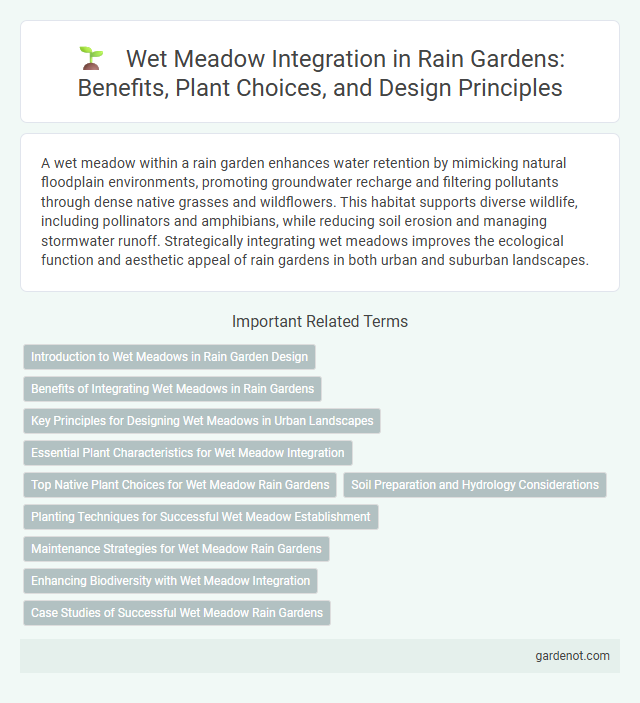A wet meadow within a rain garden enhances water retention by mimicking natural floodplain environments, promoting groundwater recharge and filtering pollutants through dense native grasses and wildflowers. This habitat supports diverse wildlife, including pollinators and amphibians, while reducing soil erosion and managing stormwater runoff. Strategically integrating wet meadows improves the ecological function and aesthetic appeal of rain gardens in both urban and suburban landscapes.
Introduction to Wet Meadows in Rain Garden Design
Wet meadows in rain garden design serve as transitional zones that enhance water absorption and support diverse native plant species adapted to periodic flooding and drying. These ecosystems improve stormwater management by slowing runoff, promoting groundwater recharge, and filtering pollutants through a mix of grasses, sedges, and wildflowers. Incorporating wet meadows into rain gardens increases biodiversity and creates resilient landscapes that withstand fluctuating moisture levels.
Benefits of Integrating Wet Meadows in Rain Gardens
Integrating wet meadows in rain gardens enhances stormwater management by increasing water retention and promoting natural filtration, reducing runoff and improving water quality. These native plant communities provide critical habitat for pollinators and wildlife, supporting biodiversity and ecosystem resilience. Wet meadows also contribute to soil stabilization and carbon sequestration, making rain gardens more sustainable and environmentally beneficial.
Key Principles for Designing Wet Meadows in Urban Landscapes
Wet meadows in urban landscapes require carefully selected native plant species that thrive in periodically saturated soils to enhance urban biodiversity and manage stormwater. Design principles include creating shallow depressions to retain runoff, ensuring soil permeability for proper water infiltration, and incorporating a diverse mix of grasses and flowering plants to support pollinators. Proper layering, seasonal water level variation, and maintenance practices are essential for sustainable wet meadow ecosystems in city environments.
Essential Plant Characteristics for Wet Meadow Integration
Wet meadow plants thrive in consistently moist, poorly drained soils and exhibit deep, fibrous root systems that enhance soil stabilization and water filtration. These species often display flood tolerance, flexible stems to withstand water flow, and seasonal adaptability to fluctuating water levels. Essential traits include high nitrogen uptake capacity and support for diverse pollinators, contributing to bioswale and rain garden ecosystem resilience.
Top Native Plant Choices for Wet Meadow Rain Gardens
Top native plant choices for wet meadow rain gardens include switchgrass (Panicum virgatum), blue flag iris (Iris versicolor), and swamp milkweed (Asclepias incarnata), which thrive in moist, periodically saturated soils. These species provide excellent erosion control, support pollinators such as butterflies and bees, and enhance water filtration. Incorporating sedges like Carex stricta and forbs like Joe-Pye weed (Eutrochium purpureum) promotes biodiversity and resilience in wet meadow ecosystems.
Soil Preparation and Hydrology Considerations
Wet meadow soil preparation requires deep tilling and incorporation of organic matter to enhance moisture retention and nutrient availability. Hydrology considerations involve ensuring seasonal saturation with well-drained conditions to prevent prolonged flooding, which supports native wetland plant species. Proper grading and hydrologic balance maintain soil aeration while accommodating fluctuating water levels typical of wet meadows in rain gardens.
Planting Techniques for Successful Wet Meadow Establishment
Selecting native, moisture-tolerant grasses and wildflowers is essential for successful wet meadow planting, as these species thrive in saturated soils and provide habitat diversity. Preparing the soil by removing existing vegetation and loosening the topsoil enhances seed-to-soil contact, promoting strong root development. Employing techniques such as broadcast seeding or hydromulching ensures even seed distribution and helps protect seeds from erosion and predation in wet meadow environments.
Maintenance Strategies for Wet Meadow Rain Gardens
Wet meadow rain garden maintenance strategies emphasize consistent monitoring of water levels to ensure optimal soil moisture for native plant health. Regular removal of invasive species and periodic mowing or controlled burns support biodiversity and prevent woody plant encroachment. Soil nutrient management through mulching and targeted fertilization enhances plant growth and resilience in wet meadow ecosystems.
Enhancing Biodiversity with Wet Meadow Integration
Wet meadow integration in rain gardens significantly enhances biodiversity by providing a habitat for diverse native plants, pollinators, and wildlife. These ecosystems support a variety of grasses, sedges, and flowering species that improve soil health and water filtration. Incorporating wet meadows promotes ecological balance and resilience in urban landscapes.
Case Studies of Successful Wet Meadow Rain Gardens
Case studies of successful wet meadow rain gardens demonstrate significant improvements in stormwater management by reducing runoff volume and enhancing groundwater recharge. Projects like the Chicago Botanic Garden's Dixon Prairie illustrate effective use of native wet meadow plants to increase biodiversity and improve water quality. These rain gardens balance aesthetic appeal with ecological function, providing habitat for pollinators and mitigating urban flooding risks.
Wet meadow Infographic

 gardenot.com
gardenot.com